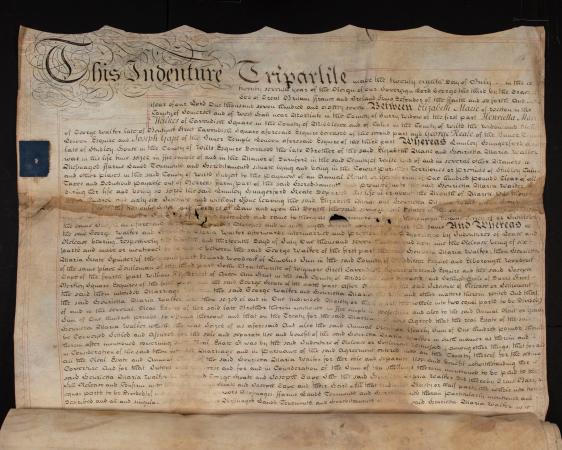We’ve had an exciting year at the Archives, filled with new projects and fresh faces. Before we dive into 2020, let’s take a look back at what we accomplished this year.
The Archives welcomed three new additions to our staff. Institutional history division assistant Hannah Byrne, curator with the American Women’s History Initiative Dr. Elizabeth Harmon, and digital imaging technician Jessica Scott have already made the Archives’ collections more accessible to researchers and our digital audiences.
In the 2019 fiscal year, the Archives Division, which comprises of reference and archives information management staff, was busy answering your burning questions, in-person, over the phone, and via email, and processing new collections. If you want to explore exactly what’s new, tune into our quarterly “Collection Highlights” series on the blog. This year, the team:
- Attended to researchers in 777 in-person visits
- Created or revised 835 finding aids to the Archives’ collections
- Accepted 243 new accessions, comprising of 587.34 cubic feetand 34 gigabytes
As an added bonus from the division, reference archivist Tad Bennicoff became our resident Smokey Bear expert and authored two new webpages on the real-life Smokey Bear, who lived at the Smithsonian’s National Zoo from 1950 to 1976.
![American Black Bear "Smokey Bear" at National Zoological Park, 1973, Smithsonian Institution Archives, SIA Acc. 11-009 [73-3886]. American Black Bear "Smokey Bear" at National Zoological Park](https://ids.si.edu/ids/iiif/SIA-73-3886/full/500,/0/default.jpg)
The Institutional History Division continued to collect oral histories from former Smithsonian employees. Staff and interns:
- Added18 oral history interviews in five collections, totaling 25 hours of recordings, to our collections
Additionally, Smithsonian historian Dr. Pamela Henson wrote a new webpage about the career of 14th Smithsonian Secretary Lonnie G. Bunch III.

In the 2019 fiscal year, the Digital Services Division digitized new materials for researchers and added to the Archives’ digital collections by capturing Smithsonian websites, social media, and so much more. Staff:
- Assessed and analyzed 142 collections with born-digital materials
- Absorbed 2.85 terabytes of original source material
- Digitized 18,964 surrogates of documents, diaries, field notes, manuscripts, photographs and audio.
For some divisions, it’s just plain tough to put their contributions into numbers. In Preservation Team highlights, staff undertook a complete rehousing and preservation photocopying for unstable materials in the moderately large collection (103 boxes, 51.69 cu. ft.) from the Office of Under Secretary Records, 1958-1973, Record Unit 137. In a smaller custom job, preservation coordinator Alison Reppert Gerber carved out space within space for a wee object in the Frank A. Taylor Papers, 1835-2003, Accession 18-009.
Addressing long-term stabilization for problematic acetate films, the team packed 111 films from National Zoological Park. Department of Zoological Research, Animal Research Records, 1954, 1968-2000 Accession 15-268 for long-term frozen storage and moved into our photo storage vault.
Conservation highlights include the transfer and assessment of 1,144 field books, with treatment plans underway.
Additionally, conservator William Bennett wrote about the preliminary stabilizing treatment of a new accession, the Hungerford Deed of Partition, Accession 19-150, which sheds valuable light on the seeds of James Smithson’s fortune, his mother’s family inheritance – and is a fascinating physical object in and of itself.
And how could we forget that time senior conservator Nora Lockshin helped fight crime by examining suspected stolen copies of Christopher Columbus’s letters.

As always, we offer a huge round of applause and our deepest gratitude to our #volunpeers who donate their time and expertise to the Archives by transcribing our collections through the Smithsonian Transcription Center? This year, volunpeers completed 109 projects, totaling 9,592 pages.
Drum roll, please! The 2019 top five blog posts, which range from web archiving to Smithsonian history to conservation, should not be missed. Below are our top five most-viewed blog posts written in 2019.
1. Searching and Using Web Archives, by Lynda Schmitz Fuhrig
Researchers, scholars, and journalists are making use of website and social media archives, and electronic records archivist Lynda Schmitz Fuhrig provided tips about how you can, too! Explore websites the Smithsonian Institution Archives has in our collections.
2. Did That Really Happen? Snake Smashin’, by Emily Niekrasz
It was your average Friday at the Smithsonian’s National Museum of Natural History on April 4, 1969. All was well. That is, until a thirty-one-year-old man pulled a hatchet and butcher knife out of a paper bag and began hacking at displays of taxidermied snakes in the Hall of Reptiles and Amphibians. After you read this post, you’ll never take a museum security line for granted again.
3. Gender Discrimination at the Smithsonian Institution, by Clara Kaul
A complete history of the Smithsonian Institution includes stories of employment discrimination. Archives intern Clara Kaul explored the experiences of anthropologist Joanna Cohen Scherer, who filed lawsuits against the Smithsonian to advocate for an end to discrimination in hiring practices. Scherer’s trailblazing changed the lives of female anthropologists both within and outside of the Smithsonian.
4. Fitting Unusual Collections into Standard Boxes, by Alison Reppert Gerber
For archival collections, fitting unusual collections within standard size boxes can be a common occurrence. Preservation coordinator Alison Reppert Gerber gave readers a behind-the-scenes glimpse into one of her many rehousing projects, which included a whole lot of creativity to create custom housing for a small, unique object.
5. M*A*S*H: Binding Up the Exhibit, by Emily Niekrasz
Thirty-six years ago, “M*A*S*H: Binding Up the Wounds” opened at the National Museum of American History, and the response was overwhelming. In this post, explore the reception to the exhibit and watch a clip of *screams* actor Alan Alda at the donation ceremony in 1983.
Last but not least, pop in those headphones to listen to clips from an oral history of ornithologist Roxie Laybourne in our collections with Smithsonian’s podcast, Sidedoor.
Cheers to 2019 and we’ll see you soon in 2020!
Produced by the Smithsonian Institution Archives. For copyright questions, please see the Terms of Use.

Leave a Comment